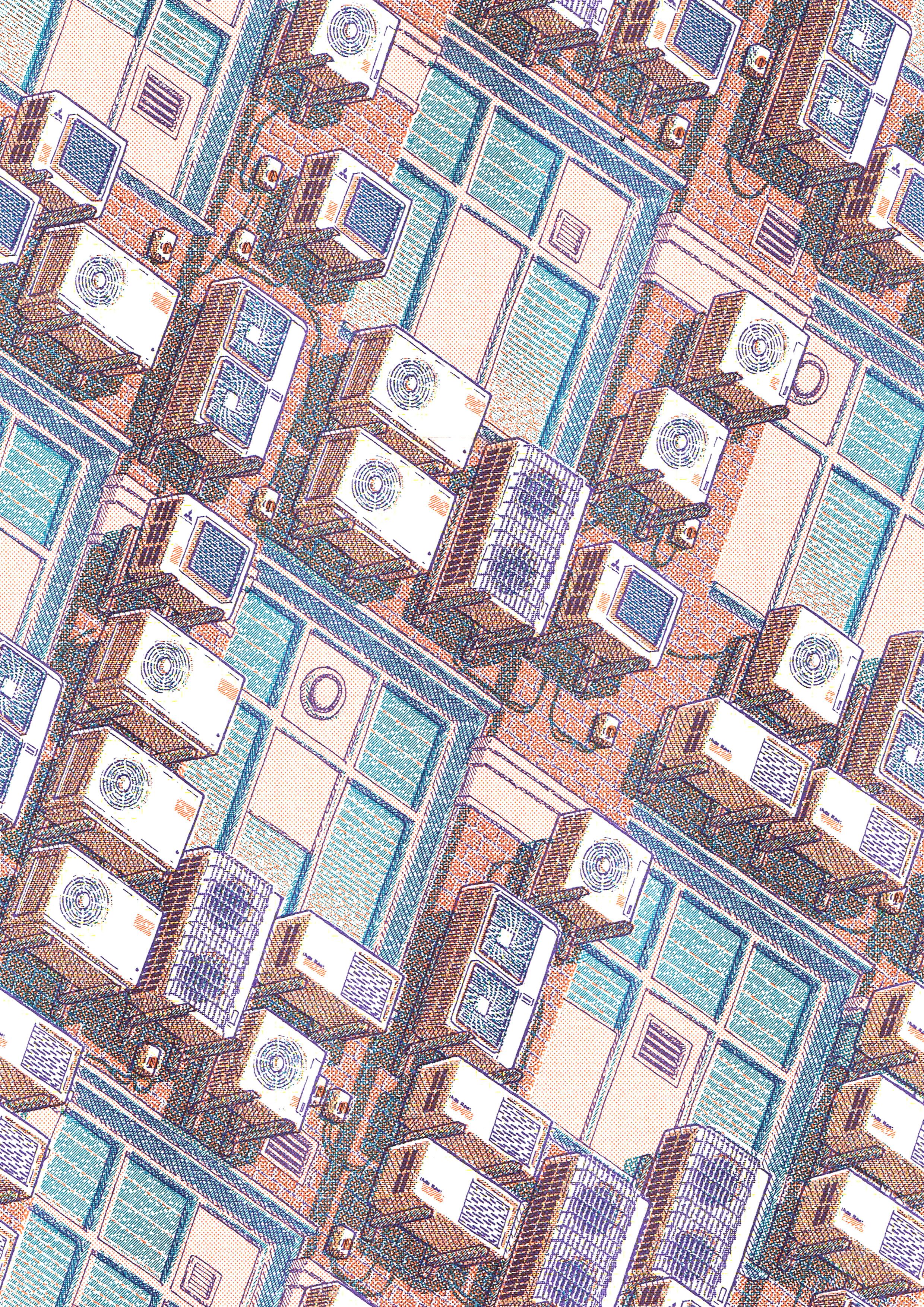
Published September 2025 as part of the proceedings of the first Alpaca conference on Algorithmic Patterns in the Creative Arts, according to the Creative Commons Attribution license. Copyright remains with the authors.
doi:10.5281/zenodo.17084408
I am a graphic artist who uses illustration and risograph print to create patterns mainly based on infrastructure and other systems that make our social structure function. Within each pattern, one tile represents a single scene and our experience of it; the accommodation we live in, the technology we use and the food we eat. These tiles repeat at every edge so their identical neighbours can seamlessly come together to make a more expanded scene. This now suggests that they are part of a much larger repeating system, one that now has logically absurd boundaries. With enough repetition, each pattern piece as a whole becomes more abstract with the details harder to make out.

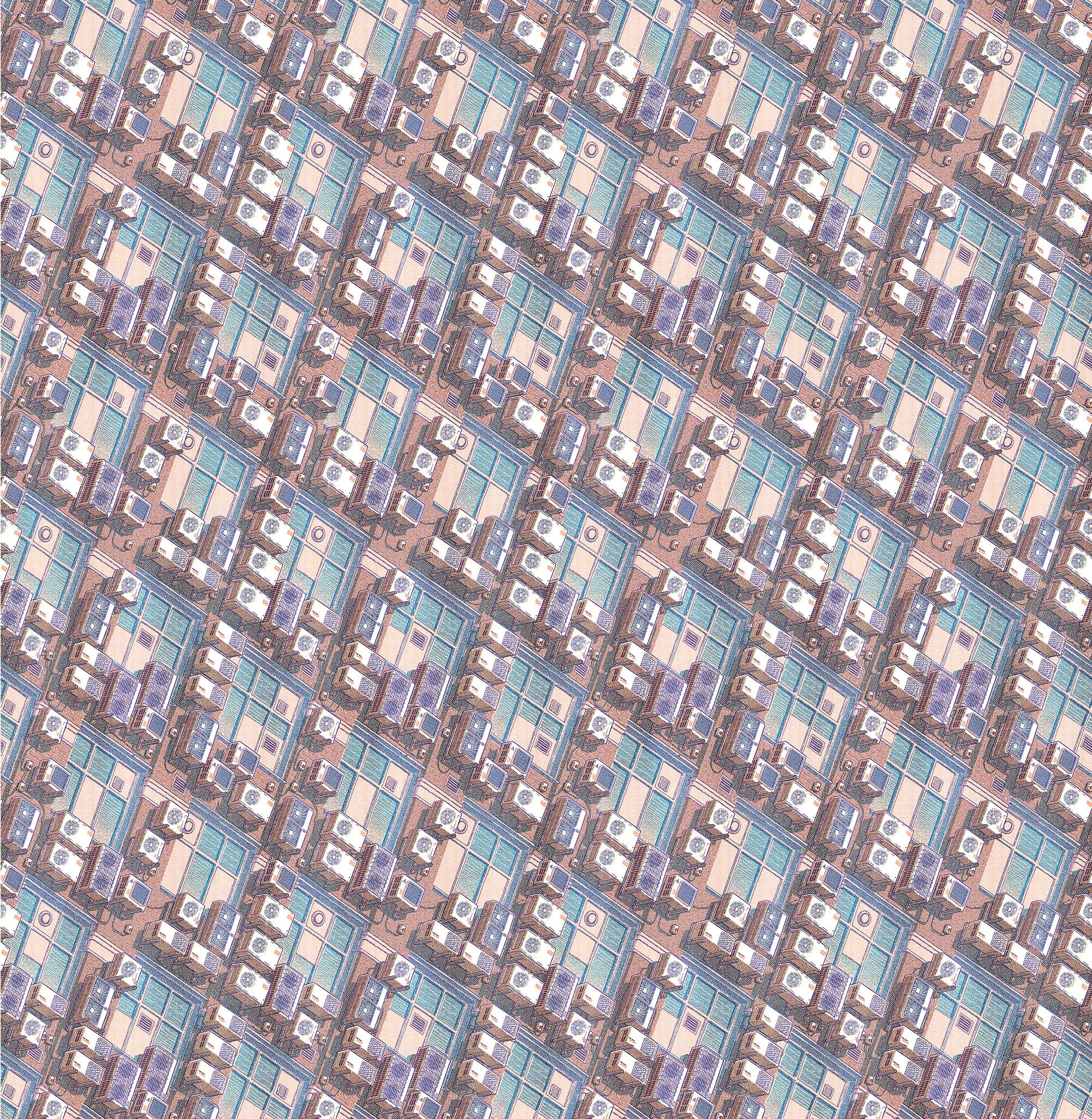
These patterns often start with a real world encounter, whether that is elements as an immediate pattern (as in stacks of shipping containers) or in their repetition of encountering (cycling past large scale construction projects and its tower cranes in Manchester).
I can trace this fascination to an off season trip to Jesolo and seeing the empty parasols and loungers on the beachfront. Due to the limited amount of space, the hotels that provide these sun loungers have arranged them all in a tightly uniform fashion to fit their own strip of beach. With no-one occupying any of the beach, this vista struck me as factory-like, ready for beach lounging on an industrial scale. I had a desire to communicate and understand the strangeness I saw in this, which led to seeing these very familiar but also very strange patterns in a lot of aspects of how we live. Within a modern civilisation this is no coincidence, its subjects are supported mostly through solutions that are tried and tested, off the shelf and mass produced. To keep up with a stable demand for energy, sustenance and space there requires a lot of repetition.
From this a practice had a starting point. Through illustration and digital arrangement I would begin experiments in creating patterns firstly around infrastructure and then broader subjects. To start, these would be within a system of overlapping elements with an eye on the final complete pattern arrangement. This resulted in a finished piece of work that would have a size limitation, usually around 2A0 (118.9 x 168.2 cm), the maximum size most large commercial printers can do. This also began to represent for me a scene that had a finite edge and was not overwhelming in its scale. The shift would be thinking to build from a scene within an individual tile and seeing what happens when this repeats further out. This would be freeing in one sense for the size and impact of the displayed work but lead to its own challenges later on.
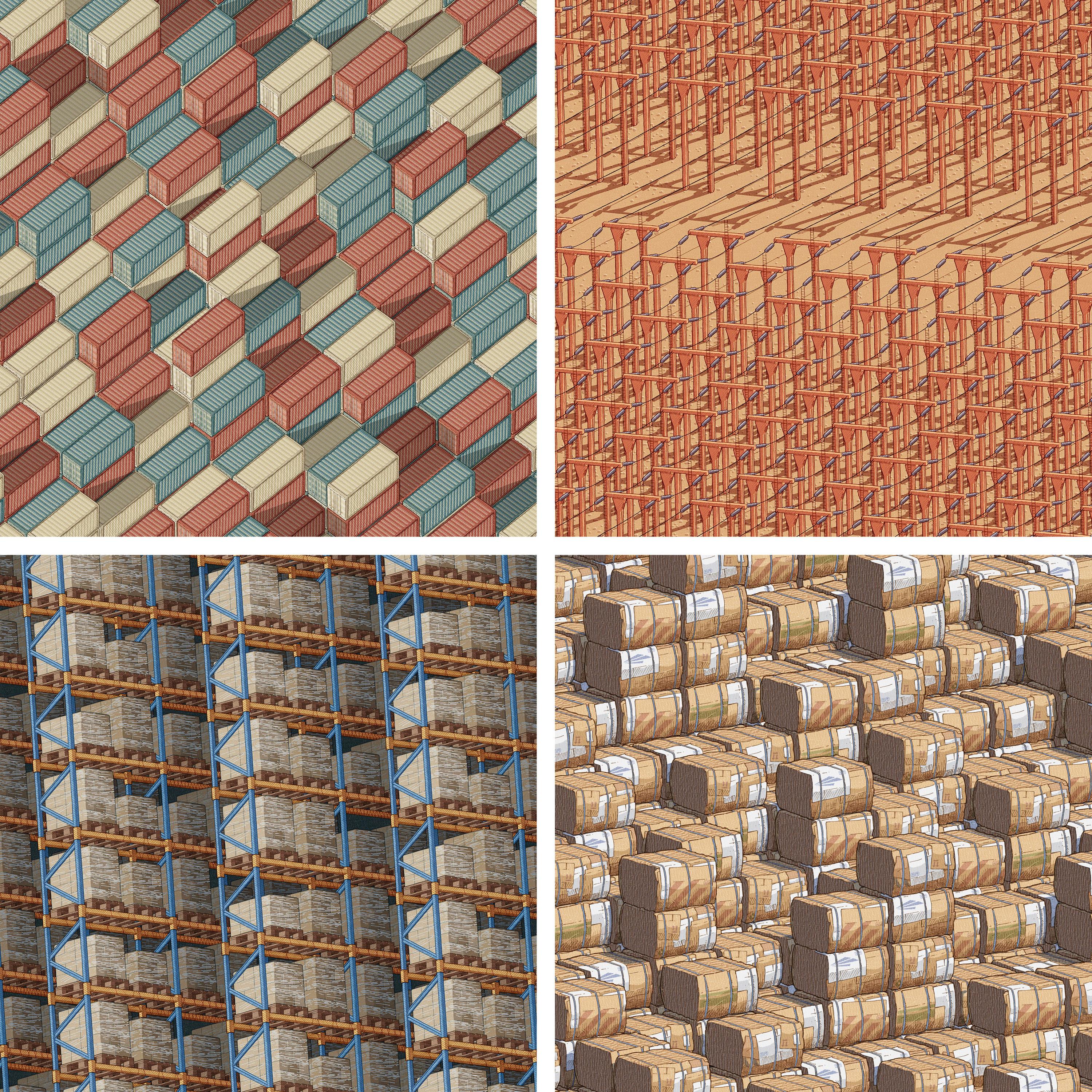
This new pattern process would lead to new rules and guidelines to keep in mind when approaching a new pattern. Some of the rules are more rigid than others, and the process is very much an ongoing one. These are as follows and I’ve included diagrams to help.
Rule 1 - Each tile should create a scene that appears rooted in reality within the confines of an A4 rectangle. In the case of the tower cranes, they must ‘tower’ when repeated as a pattern and feel as tall as they do when seen against a building. To achieve this meant putting all elements on an angle and having the tower ‘stripe’ across the tile (figures 4 & 5). I want to avoid exaggerating or distorting the elements of the pattern to make the viewer feel like this is the uncanny aspect of infrastructure. The scene should not look improbable in the real world, and in that I take great lengths to hide the tiles repeat from where the viewer expects to find it.
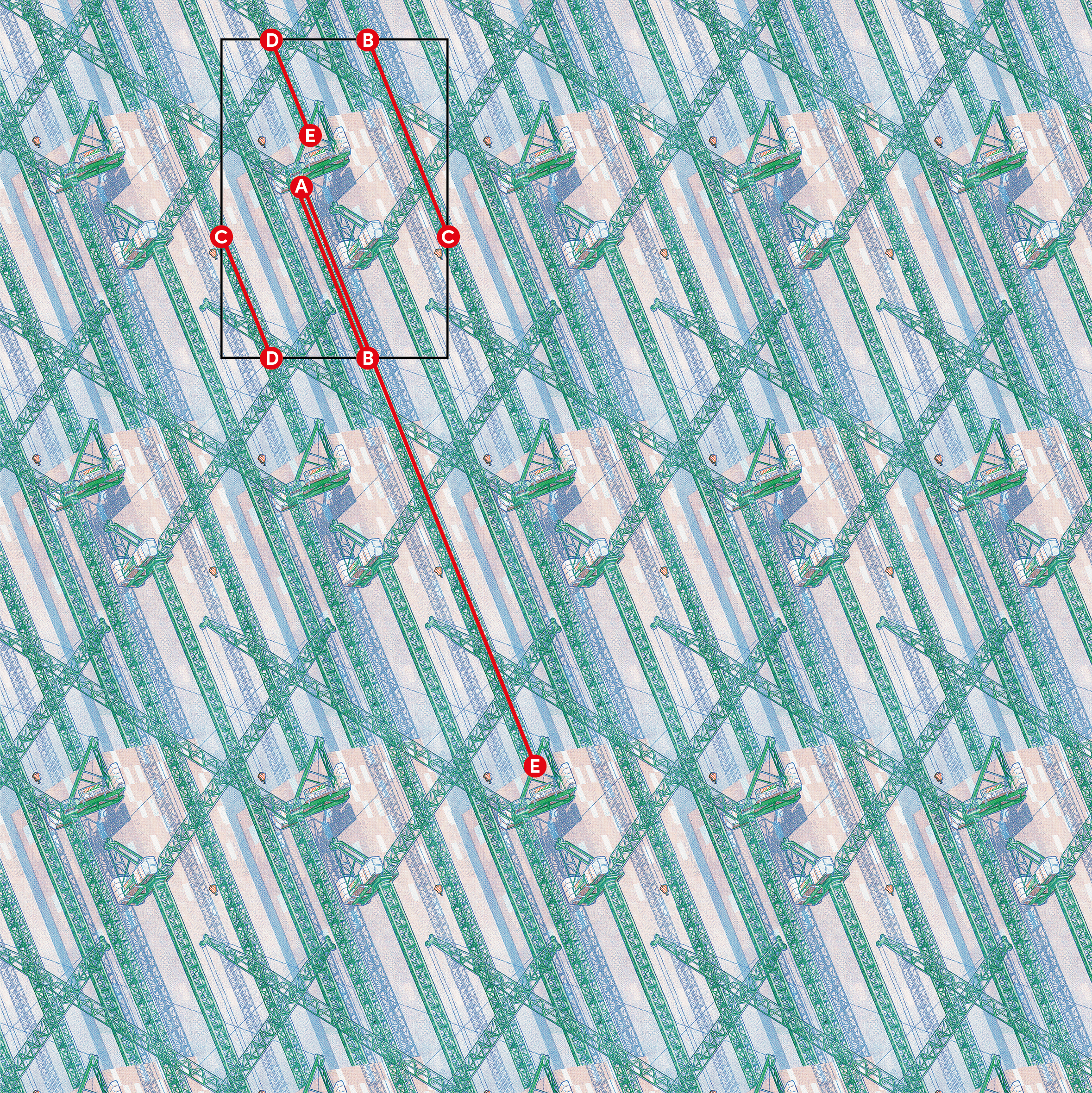
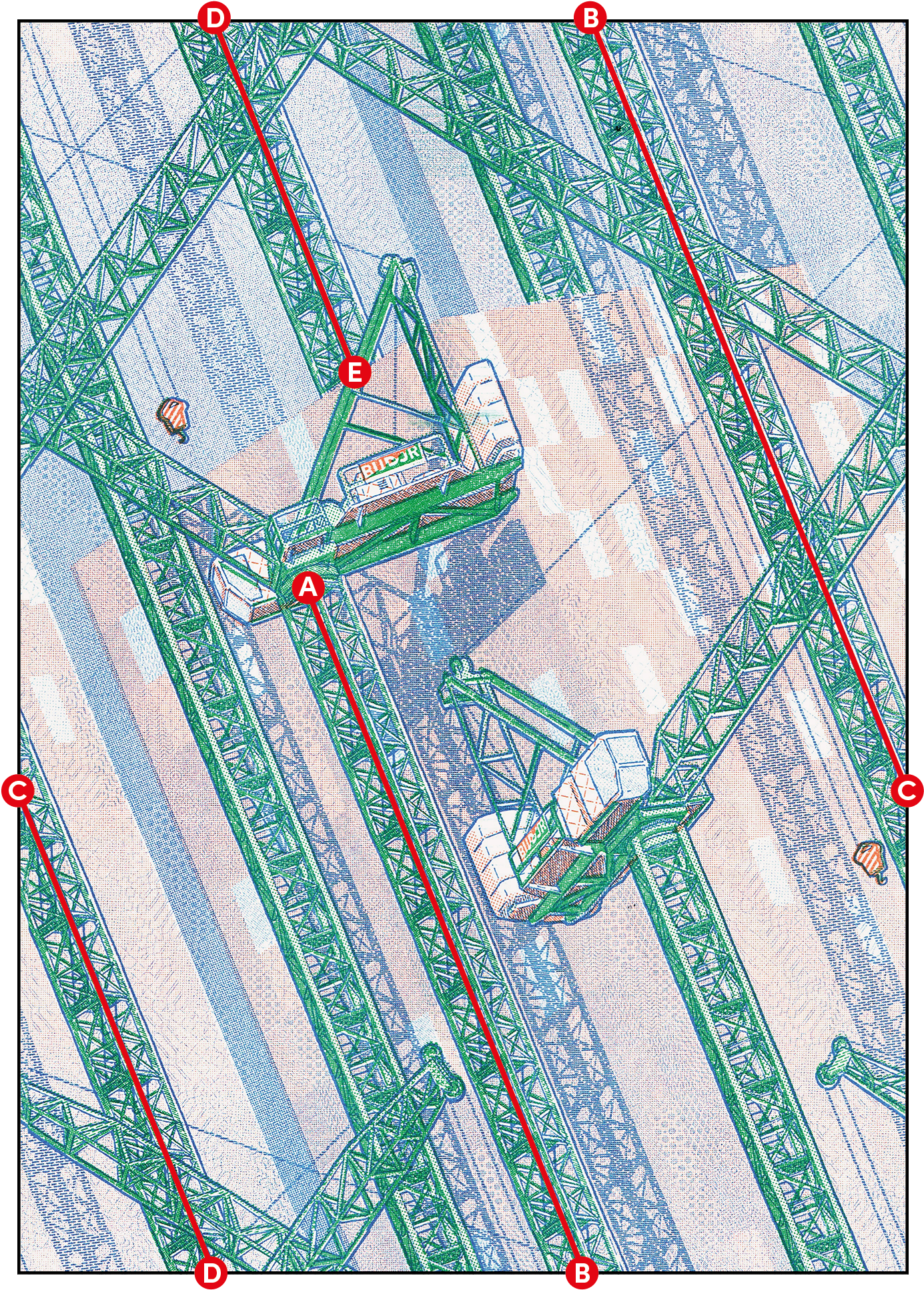
Rule 2 - There is an aesthetic requirement to the pattern elements. I want each tile to be clear to understand and a direct communication of an idea. Within my practice,I feel that illustration over other media allows this focus, requiring an active decision to draw and include elements. These scenes should anchor the viewer, it’s through being multiplied enough times this gets increasingly blurred and homogeneous creating something more abstract.
Rule 3 - The assembly of the patterns is part of the artwork. Printing the patterns on a risograph printer means repetition and work into keeping the print layers aligned. Individually cutting edges to make sure the individual pieces line up with each other properly. Combined with assembling the pattern tiles to create a larger piece and figuring out joining is where flaws creep in, despite my best efforts. A millimeter gap in one part leads to a larger gap in another. This part of the practice used to feel like a means to an end but now the constant adjustment and human input to keep a repeat process in check reflects the system I’m trying to understand.
Rule 4 - Leading on from rule 3, the amount of repetition and the scale of the final piece matters. I assess the maximum amount of exhibition space I can attempt to fill, and balance this with the cost and labour that goes into creating a large scale piece. Every tile is designed to be endlessly repeatable, as are real world systems, but there is a very real limit to size in both. A consideration has to go into the physical load of tiles against its neighbour above, I’ve tried out various methods now of joining the pattern tiles together and have plans for others. Currently I’m using fibreglass reinforced tape and really have to cross brace and reinforce edges with it; A lesson learnt from tape failures with displayed patterns that have required emergency repairs.
Having a framework to create the patterns has led to me being more satisfied with the outcomes. They force me to use more interesting perspective lines, be more critical with the function of the illustration work and be sparing with how much information I want to cram into a scene. These processes have made me more attuned to seeing repetition and where it reveals itself within my surroundings, providing inspiration for future explorations.
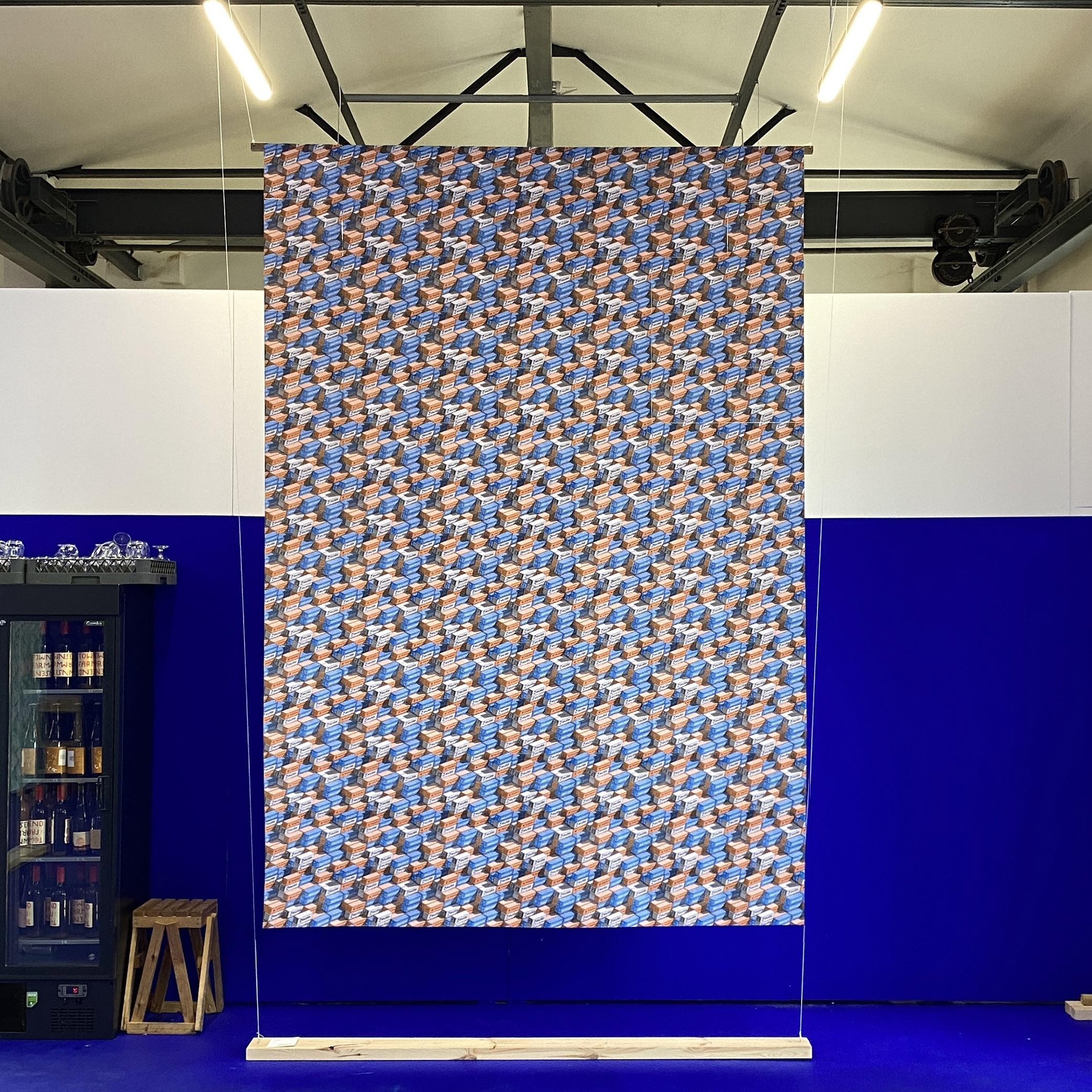
Last year (Aug, 2025) I held an exhibition titled SCALE at Altogether Otherwise in Manchester. The building, formerly an industrial unit with offices, has now been converted into a workshop and event space for mainly tactile practices (ceramics, woodwork, urban gardening etc). This was an incredible opportunity to explore the rule’s practical translation to a space this size and with an audience very aware of their inner city surroundings. On a technical level, rules 3 and 4 were workshopped in the studio and on site too. The height of the space to the steel beams is 3.8m which could accommodate a pattern height of approx 3m. The full size pieces I kept roughly to the A paper format ratio, using 100 tiles in a 10 x 10 configuration giving me a width just over 2m. This meant with printing each piece would be a full day to assemble. On site, the artwork meant figuring out a way to hoist the patterns into place and secure them once up (very sail boat-like). The act of installation helped to figure out what sort of stresses were put on the assembly of the patterns, including weaknesses in paper joins and where to prevent these in future.
Once the work was up and the public allowed in to view, conversations could be had on how the scale of the work affected the audience’s participation with it. The benefit of such a large space was allowing the viewer to really walk around the work. By stepping back, the size of the pattern meant that the viewer would see each tile blend into one textured mass. This has always been the goal with the patterns and one I could create digitally on screen, but harder to work out whether the effect would translate to an installation. The reverse of this when the viewer steps towards the pattern, the details are fully revealed of one tile, the surrounding tiles repeat and loom over and around this. This invokes a nagging feeling that there is a lot more beyond what we can immediately focus on.
With this scale I get closer to what I want to convey with the patterns, even though each tile does represent an infinite system, it definitely helps to see a bigger slice of that infinite. Without directly referencing the themes of climate change, consumption and ceaseless economic growth, being able to see our systems as just the repetition, and being a little overwhelmed by it, can help us imagine what those consequences would be.